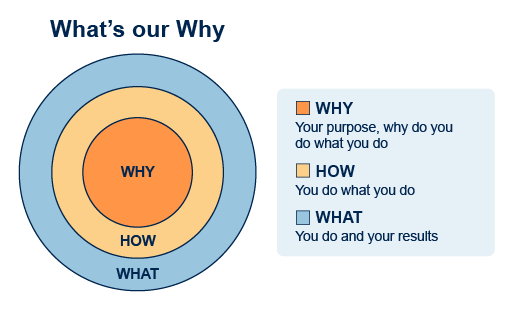2.1 The Golden Circle and 5 Ws and H
Simon Sinek, an author and inspirational speaker, uses the Golden Circle theory to assist leaders establish and understand their ‘why’. His belief is that most people will know the ‘How’ and ‘What’ an organisation does, but not necessary the ‘Why’. The ‘Why’ for organisations is often encapsulated in their mission statement. The vision statement reflects the ‘What’, and the values and objectives statements describe the ‘How’. The figure provides an overview.
An alternative simple approach for establishing what and why is to ask the 5 Ws and H questions for assessing why change is needed. If you consider the decisions you make every day, you may unconsciously use this approach. For example, when you go shopping; ask yourself:
- What do you want to buy?
- Why do you need it?
- Where will you get it from?
- When are you going to go?
- Who needs to come with you?
- How will you get there?
When applying this approach in an organisational context, you will have different questions depending on the change you are being asked to consider. Some example questions are shown in the table below.
| What | Why | When | Where | Who | How |
|---|---|---|---|---|---|
What is the desired outcome? What is the benefit of doing this? What if we don’t do it? |
Why do we need it? Why is it needed now? |
When is it needed by? |
Where is it needed? |
Who asked for the change? Who needs to be involved? Whom does it impact? |
How will it be done? |
The order can vary depending on the context, but arguably the two most important Ws are the Why and the What, as these will help to inform the questions you may want to ask for the When, Where and Who in order to establish the How.
Why: You need to establish why this change is actually required so you can make the decision whether to proceed. Throughout the process you should always come back to the Why, even when a decision has been made.
What: The actual outcome desired needs to be established. Often when a change is requested, the first outcome stated is not always the actual outcome that is needed. Using the 5 Ws approach helps to surface what is needed and whether it is actually required. You may in fact decide to stop.
Once you are confident that you have your Why and your What, you can then start to focus on the How.
If you are a public body based in Wales, you may wish to link to the following frameworks list below:
- Future Generations Framework for scrutiny [Tip: hold Ctrl and click a link to open it in a new tab. (Hide tip)] (Future Generations Commissioner for Wales, 2019)
- Future Generations Framework for service design (Future Generations Commissioner for Wales, 2018)
- Future Generations Framework for projects (Future Generations Commissioner for Wales, n.d., a)
- Guidance on using the Future Generations Framework for projects (Future Generations Commissioner for Wales, n.d., b)
These provide guidance on how to establish the connections of your change initiatives or projects to the Well-being of Future Generations (Wales) Act 2015’s seven wellbeing goals and consider their five ways of working.
If you are not familiar with the wellbeing goals and five ways of working, you may wish to review the Sustainability and wellbeing section in the Hybrid working: organisational development course.
Activity 2 What are you trying to change?
In this course you will be looking at how you can implement change management at your organisation. To begin, you should take the time now to think about a particular change in your organisation and the scope of what it is you are trying to change.
If you do not have a change to implement, you may wish to use one of the ‘Simple Changes’ on the Future Generations Commissioner for Wales (2022) website.
Use the following questions as prompts:
- Why are you doing it; what are the drivers?
- What technology will be involved in supporting the change?
- What processes will the change impact?
- Who will be impacted and how?
- How do you think they will react to the need for change?
- How do you think they will feel about the change itself?
- What benefits will the change bring?
You can use the text box below to capture your reflections, if you wish.

